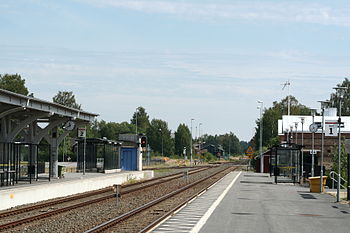Vaggeryd – Jönköping railway line
| Vaggeryd – Jönköping | |||||||||||||||||||||||||||||||||||||||||||||||||||||||||||||||||||||||||||||||||||||||||||||
|---|---|---|---|---|---|---|---|---|---|---|---|---|---|---|---|---|---|---|---|---|---|---|---|---|---|---|---|---|---|---|---|---|---|---|---|---|---|---|---|---|---|---|---|---|---|---|---|---|---|---|---|---|---|---|---|---|---|---|---|---|---|---|---|---|---|---|---|---|---|---|---|---|---|---|---|---|---|---|---|---|---|---|---|---|---|---|---|---|---|---|---|---|---|
|
Vaggeryd railway station
| |||||||||||||||||||||||||||||||||||||||||||||||||||||||||||||||||||||||||||||||||||||||||||||
| Route number : | 83 | ||||||||||||||||||||||||||||||||||||||||||||||||||||||||||||||||||||||||||||||||||||||||||||
| Route length: | 35 km, from 1972: 38 km | ||||||||||||||||||||||||||||||||||||||||||||||||||||||||||||||||||||||||||||||||||||||||||||
| Gauge : | 1435 mm ( standard gauge ) | ||||||||||||||||||||||||||||||||||||||||||||||||||||||||||||||||||||||||||||||||||||||||||||
| Power system : | Jönköping C – Jönköping gbg: 15 kV, 16⅔ Hz ~ | ||||||||||||||||||||||||||||||||||||||||||||||||||||||||||||||||||||||||||||||||||||||||||||
| Maximum slope : | 16.67 ‰ | ||||||||||||||||||||||||||||||||||||||||||||||||||||||||||||||||||||||||||||||||||||||||||||
| Minimum radius : | 300 m | ||||||||||||||||||||||||||||||||||||||||||||||||||||||||||||||||||||||||||||||||||||||||||||
| Top speed: | Bandel 715 (Jönköping central) –Jönköpings gbg: 60 km / h Bandel 731 (Jönköping gbg) - (Vaggeryd): 100 km / h |
||||||||||||||||||||||||||||||||||||||||||||||||||||||||||||||||||||||||||||||||||||||||||||
| Operating points and routes | |||||||||||||||||||||||||||||||||||||||||||||||||||||||||||||||||||||||||||||||||||||||||||||
|
|||||||||||||||||||||||||||||||||||||||||||||||||||||||||||||||||||||||||||||||||||||||||||||
The Vaggeryd – Jönköping railway is a 35-kilometer standard-gauge railway in Sweden . It was built by Halmstad – Nässjö Järnvägsaktiebolag (HNJ), a private railway company , between Vaggeryd and Jönköping .
history
The Halmstad – Nässjö Järnvägsaktiebolag took up the plan of the bankrupt Halmstad – Jönköping Järnvägsaktiebolag , like the predecessor company, to build a railway line to Jönköping. Since the main line now led to Nässjö , the possibility of a branch line from Götafors to Jönköping was examined in 1883 , which could not be built for lack of money.
In 1889 E. Westerberg was commissioned by Vägoch vattenbyggnadskåren to work out a proposal for a standard-gauge railway between Vaggeryd and Jönköping. A group of local politicians and business people applied for a concession for this route, which was granted on May 9, 1890. Due to some restrictions in this concession, the plans of Carl Johan Jehander were revised. His proposal to build a freight and marshalling yard south of the Munksjö paper mill and a station at the harbor was approved on September 4, 1891.
Before that, there were considerations to run the line like the Jönköping – Gripenberg (JGJ) line in the Kosta system , a Swedish variant of the Decauville - field railway with a gauge of two Swedish feet . The two lines were to merge south between Rocksjön and Munksjön, for example at the point where the Jönköping marshalling yard is today . However, after the concession was granted, the line was built in standard gauge and only the JGJ was built in the Kosta system .
The holders of the concession were able to win the HNJ over to take over the train traffic on the planned route. The company had the costs for the construction itself calculated and came with 1,185,000 kroner, roughly the same as Westerberg's estimate of 1,075,000 kroner.
After negotiations, the HNJ also took over the concession on April 1, 1892 and commissioned Carl Jehander to build the line. The opening for public transport took place on November 12, 1894. The line was built with rails weighing 22.5 kg / m per meter , the maximum speed at that time was 40 km / h.
nationalization
As part of the general nationalization of the railways , the HJN and with it the Vaggeryd – Jönköping line passed into state ownership on July 1, 1945; Statens Järnvägar took over management .
Routing
The entrance to Jönköpings Hamns personbangård station , which was the end of the line, was on the west bank of Munksjön via Jordbrons lastplats , the Munksjö industrial area and Jönköpings Hamns godsbangård . A connecting track led from Jönköpings Hamns personbangård to Jönköpings statsbanestation .
In 1972 the route was changed, from then on the trains to Jönköping C took the same route as earlier trains on the Borås – Jönköping line, which was closed in 1960 . The detour via the marshalling yard and Rocksjön was three kilometers. In the same year, the four-kilometer line between Jönköping C and the marshalling yard was electrified.
business
As one of the first routes in Sweden, the connection was released in 1985 under the name Krösatågen as a regional railway company . The name was later replaced by Länstågen , but exists again today. In recent years Länstrafik has concentrated on direct connections between the largest cities in Småland from Jönköping to Växjö via Vaggeryd and Värnamo. For this reason, the line is still in operation today, although Statens Järnvägar planned to shut it down as early as 1971 .
The passenger trains are operated by DSB Småland AB on the Jönköping – Värnamo – Växjö route, and diesel multiple units of the Y1 and Y31 / Y32 series are used . Freight traffic takes place mainly between Jönköping freight yard and Månsarp (–Torsvik). The new track triangle at Månsarp enables traffic from Torsvik towards Vaggeryd. The Jönköping C – Jönköping marshalling yard route is served by several trains per day.
Individual evidence
- ↑ JNB 2018 Bilaga 3rd E STH och medelhastighet per sträcka. (PDF) Utgåva 2017–12–08. trafikverket.se, March 12, 2018, p. 134 , accessed April 2, 2018 (Swedish).
- ^ Vaggeryd – Jönköping / Västerbrunn – Jönköpings hamn. Bandel 529, SJ district 8 bs. In: banvakt.se. Retrieved October 13, 2013 (Swedish).
- ^ Per Englund: Decauvillesystemet - från Paris till mörkaste Småland. (PDF; 211 kB) KUNGLIGA TEKNISKA HÖGSKOLAN, Avdelningen för teknik- och vetenskapshistoria, May 27, 2009, archived from the original ; Retrieved April 25, 2019 (Swedish).
- ↑ Original route
Web links
- Route data (swedish)
- Overview map
- Jonkoping-Vaggeryd. Vaggerydsbanan. jarnvag.net, accessed February 4, 2016 (Swedish).
- DSB Småland del i Sverigeexpansion. dsbsmaland.se, archived from the original on February 22, 2014 ; Retrieved February 4, 2016 (Swedish).
- Krösatågen (Swedish)
